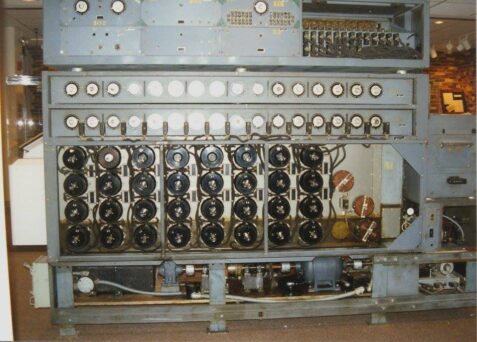The American Naval Bombe N-530
General Overview

Rear View
Brief description
In general terms, these machines were basically the same as British Turing-Welchman machines but engineered in a different manner.
Wheel orders have to be worked out in the same way as Bletchley Park and a menu created by first eliminating clashing letters.
Stops occur in a similar manner. Indicator Drums, in this case, are not read visually but instead are printed in columns on the printer
A menu is not loaded with plugs and cables but instead, this is achieved by selecting the input and output 27-way rotary switches relating to the sixteen Letchworth Enigmas
The Job throughput on 4wheel jobs is very similar to the High-Speed Keen but it scores on 3wheel jobs by running through a complete menu in less than two minutes. Stops are semi-automatic because if a stop is detected and not valid then the machine starts again. The process of stopping, printing where applicable and restarting takes time and tends to make the speed whilst running only a small part of the overall run time. In this case, there is no need for those operating the machine to write down the ‘stop’ details.
The machine is heavier than ours, weighing about double, at around 2 tons. It has a similar but slightly different motor and clutch mechanism with pumped lubrication.
It has an encased oil filled gearbox with speed reductions and inbuilt Geneva mechanisms that progress the drums in a non-linear rotation: similar in some ways as to the High-Speed Keen, Drunken Drive.
As with the BTM machines, drums are wired to resemble the original Enigma wheels. Reflectors have similar functions but are located individually with each Letchworth Enigma. There are two additional ‘white’ drum types that relate to the fixed wheel in a 4wheel enigma machine. The High-Speed Keen also has the equivalent fitted to the 36 spindles at the very fast end.
There are 16 Letchworth enigmas but only one menu can be loaded as there is only one Diagonal board. This can be accessed in a number of ways with results printed on the line printer. These results are somewhat similar to the Jumbo machine gun with more information recovered at each stop. This makes the following ‘clonking’ process simpler.
Sensing is more precise. Whereas British machines relying on high-speed relays, the N-530 has valve (tube) technology and can easily operate at the speeds required. The valve sensing must be similar to that used in the Cobra valve sensing unit but this has yet to be established.
On the next page is a layout of the main electronic chassis. This will be referred in future chapters
N-530 Chassis Layout
Front View – Top removable chassis
Left to Right
- Amplifier
- Relay
- Neon
- Diagonal Board

Bottom View – Top removable chassis
Left to Right
- Regulator
- Printer Control
- Thyratron
Note: in some images of the machine the upper removable chassis may be fitted the other way around or in a different order
The top units can be unplugged and lifted off in order that the machine can be taken through low doorways
Lower Chassis in main frame
Motor Control Chassis

